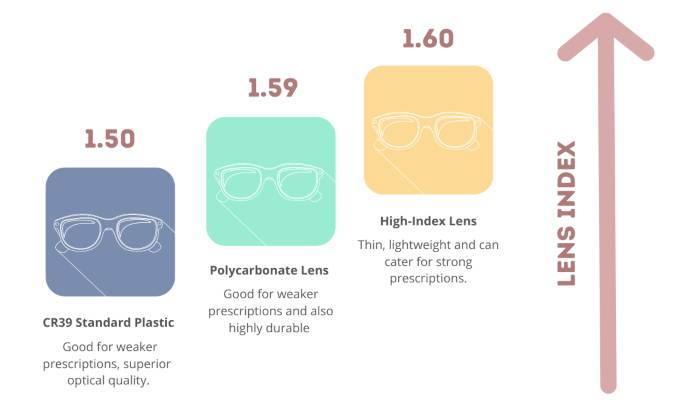TLDR: Lenses with an index of 1.60 and higher are called high-index lenses. They refract light more effectively and have thinner profiles, therefore are often used for glasses with strong prescription. See how to pick yours.
If you’re shopping for eyeglasses, you’ll probably come across the term ‘lens index’ and ‘high index lenses’. Understanding how they relate to your eyesight is an important part of choosing the right lenses for your eyes. Read on to have it all demystified!
First – Let’s talk about lens index
It’s really quite simple. Lens Index, also known as ‘refractive index’, is a number that represents how efficiently a lens material is able to bend light. For prescription lenses, this number usually ranges from 1.50 to 1.74. The higher the lens index number, the more ‘effective’ the lens at bending light!
In the past – the stronger your prescription, the thicker your lens needed to be. This meant that anyone with a very strong prescription had no choice but to suffer thick and heavier lenses, which could be uncomfortable since they weigh heavier on the nose.
However, using a higher-index material allows lenses to be thinner and more lightweight, making them an ideal choice for anyone with a strong prescription.
When you’re buying eyeglasses, you’ll usually be given a choice between lens materials and indexes. There’s a whole world of choice out there, but here are 3 common examples of lens materials offered by eyewear providers, each with a different lens index between 1.50 and 1.60:
What are high index lenses?
Lenses with an index of 1.60 and higher are often called high-index lenses. These high-index eyeglass lenses are a great option for anyone looking for stylish and comfortable glasses that can be worn all day.
They’re often recommended for those needing a strong prescription since high-index lenses can accommodate all sorts of visual corrective needs, including farsightedness, nearsightedness and high astigmatism without needing to get bulky.
Our Mouqy high index lenses (1.60, 1.67 and 1.74) are made using a special type of material that is designed to refract light more effectively. This allows them to be cut thinner without compromising on vision correction. With the right anti-glare coating, these lenses can even work to sharpen eyesight.
The big benefits of high index lenses
Here’s why many people prefer high index lenses over traditional thicker ones:
- They’re compatible with almost any style of frameWhilst thick lenses can only be worn with select types of frames, high-index lenses can be paired with many different styles – including rimless or semi-rimless styles! However, this can vary depending on the prescription.
- They’re lightweight and more comfortable to wearAs high index lenses are cut thinner, they weigh a whole lot less than standard thick-cut lenses. This makes it more comfortable for the wearer’s nose and ears, even after long hours of wear.
- You’ll get more choices of lensHigh index lenses can cater to both strong and weak vision correction prescriptions, and they’re available in plenty of options.
- They look amazingGone are the days where you’re limited to using thick, bug-eyed looking lenses. High index lenses are cut thin and are aesthetically pleasing, allowing you to pair them with frames that are actually compatible with your face shape.
Due to the materials needed to produce them, high-index lenses do come at a higher cost compared to standard plastic lenses.
How to choose your lens index at Mouqy?
Most of our Mouqy eyeglasses can be fitted with standard, polycarbonate and high-index lenses. Here’s an overview of the options we offer, their special qualities, and who they may be best suited for:
1.53 index lens
Recommended for:
- Low prescriptions
- SPH between +3.00 to -3.00 and below
- CYL below -1.50
- Full rim or semi-rimless frames
1.56 index lens
Recommended for:
- Low prescriptions
- SPH between +3.75 to -4.00 and below
- CYL below -2.00
- Full rim or semi-rimless frames
1.59 index lens
Recommended for:
- Low to moderate prescriptions
- SPH between +4.00 to -5.00 and below
- CYL below -3.00
- Full rim, semi-rimless or rimless frames
1.60 index lens (high-index)
Recommended for:
- Moderate to strong prescriptions
- SPH between +4.00 to -6.75 and below
- CYL below -3.00
- Thin cut
- Full rim, semi-rimless or rimless frames
1.67 index lens (high-index)
Recommended for:
- Strong prescriptions
- SPH between +4.00 to -9.00 and below
- CYL between -3.00 to -4.00
- Super-thin cut
- Full rim, semi-rimless or rimless frames
1.74 index lens (high-index)
Recommended for:
- Very strong prescriptions
- SPH between +4.00 to -9.25 and above
- CYL between -4.00 to -6.00
- Ultra-thin cut
- Full rim, semi-rimless or rimless frames
Lens index comparison
| Lens index | Thinness* | Prescription | SPH | CYL | Frames |
| 1.53 | 15% thinner | Low | +3.00 to -3.00 and below | Below -1.50 | Full rim / semi-rimless |
| 1.56 | 20% thinner | Low | +3.75 to -4.00 and below | Below -2.00 | Full rim / semi-rimless |
| 1.59 | 25% thinner | Low – moderate | +4.00 to -5.00 and below | Below -3.00 | Full rim / semi-rimless / rimless |
| 1.60 (high-index) | 25% thinner | Moderate – strong | +4.00 to -6.75 and below | Below -3.00 | Full rim / semi-rimless / rimless |
| 1.67 (high-index) | 30% thinner | Strong | +4.00 to -9.00 and below | -3.00 to -4.00 | Full rim / semi-rimless / rimless |
| 1.74 (high-index) | 35% thinner | Very strong | +4.00 to -9.25 and above | -4.00 to -6.00 | Full rim / semi-rimless / rimless |
Are high index lenses the right choice for me?
Whilst it’s always best to speak with your eyecare professional regarding your need for high-index lenses, here are a few things that might indicate that high index lenses are a great choice for you:
- You need a strong prescriptionAlthough high index lenses come in plano (non-prescription) and standard (prescription) forms, they’re especially beneficial for those with a strong prescription as you’ll be able to correct your vision without having to resort to wearing heavy, thick-cut lenses.
- You’re sensitive to the weight of your eyeglassesIf your glasses fit you right but feel uncomfortable, or keep slipping down your nose, it’s a very strong indication that they’re too heavy for you. Switching to high index lenses and lighter frames can help. Remember, your glasses should sit stably on your face without causing any discomfort, even when you’re doing some light running.
- You’re motivated by styleEverybody likes looking good, and it can be hard to feel your best if your spectacles give you that ‘bug-eyed’ look because of their thickness. High index lenses look aesthetically pleasing with almost any style, so you can look great and feel confident.
- You’re looking for rimless or semi-rimless framesIf you’re into rimless or semi-rimless frames, you’ll be disappointed to find that your traditional lenses probably won’t fit in them. Even if they do, the lenses might protrude from the frame which can damage them. Thin high index lenses work very well with rimless and semi-rimless frames.
That said, if your daily life involves a lot of contact sports or strenuous activities, you might want to lean towards polycarbonate, Trivex or Tribrid lenses since they are the most durable.
How to choose lens index for non-prescription glasses
Lens index isn’t just relevant for prescription glasses!
If you’re ordering non-prescription (a.k.a. “plano”) glasses, many eyewear providers will still allow you to choose between different lens materials with different indexes. At Mouqy, all our plano glasses come in Index 1.60 Aspheric. These are:
- Slim and lightweight, ideal for full frame, half-frame and rimless frame glasses.
- Great for moderate to strong prescriptions.
- Offers good optical performance whilst being thin and flattering.
Whilst CR39 1.5 index offers the best optical performance in terms of clarity, the Polycarbonate 1.59 may be a better option if your daily life involves a lot of exercise or strenuous activity.
Now that you understand lens index, you’re all set!
Now you know everything you need to know about Mouqy lenses!
All our lenses are available at affordable prices, and you’ll get to choose between clear lenses, or blue light blocking lenses. Our glasses also come with anti-glare, anti-reflective, and scratch-resistant coatings.
All you have to do now is to pick a frame and select the lens which best suits you.
Start hunting for your next favorite pair of eyewear today!

















